Study on Non-Destructive Testing Method of Existing Asphalt Pavement Based on the Principle of Geostatistics
Abstract
:1. Introduction
2. Research Methodology
3. Basic Relationship Between Cracking Rate and Deflection
4. Characteristic Section Division Based on Crack Rate Guidelines
4.1. Singularity Analysis Algorithm
- (1)
- For any given spatial location, define the shape of the spatial window, with the window size increasing in sequence, such as ;
- (2)
- Calculate the average crack rate in each window;
- (3)
- In double logarithmic coordinates, take as the horizontal axis and as the vertical axis, and perform a linear fit to the data to estimate the slope of the linear model;
- (4)
- repeating steps (1)–(3) by moving the window series to other positions to obtain a map of the spatial distribution of the local singularity index.
4.2. Singularity Index Analysis
4.3. Characteristic Sections Division
5. Deflection Detection Method Based on Kriging Interpolation
5.1. Analysis of the Interpolation Effect of Deflection Data in Different Dimensions
- (1)
- Single-lane data interpolation analysis
- (2)
- Multi-lane data interpolation analysis
5.2. The Impact of Data Variability on Kriging Interpolation
5.3. Detection Spacing Analysis Based on Kriging Interpolation
6. Non-Destructive Testing Method Based on the Principle of Geostatistics
7. Conclusions
- (1)
- A positive correlation has been observed between the crack rate and the deflection index; however, the relationship model for different road surface structures varies. It has been demonstrated that the thickness of the asphalt mixture structure layer has a direct impact on the deflection, with greater thickness leading to a reduction in the effect of the crack rate on deflection.
- (2)
- The singularity index principle has been demonstrated to be an effective method for identifying the characteristic data of the crack rate. Furthermore, the data analysis method that utilizes fixed intervals has been shown to identify characteristic sections with high or low crack rates.
- (3)
- Kriging interpolation is more effective than linear interpolation for predicting deflection data. The interpolation effect is limited by the variation of the data being interpolated. Kriging interpolation is most effective when the original data is one-way lanes matrix.
- (4)
- When the detection spacing is maintained within the variable range index, Kriging interpolation can predict deflection with a limited amount of deflection data. This analysis can be used to examine the trend of deflection index changes when the detection conditions are limited.
Author Contributions
Funding
Institutional Review Board Statement
Informed Consent Statement
Data Availability Statement
Acknowledgments
Conflicts of Interest
References
- Baltrušaitis, A.; Vaitkus, A.; Židanavičiūtė, J. Asphalt Pavement Compaction Control: Relevance of Laboratory and Non-Destructive Testing Methods of Density. Balt. J. Road Bridg. Eng. 2022, 17, 143–166. [Google Scholar] [CrossRef]
- Ziari, H.; Behbahani, H.; Izadi, A.; Divandary, H. Field Evaluation of Nondestructive Tests in Measuring the Pavement Layers Density. J. Appl. Sci. 2010, 10, 3091–3097. [Google Scholar] [CrossRef]
- Huang, Z.; Xu, G.; Zhang, X.; Zang, B.; Yu, H. Three-dimensional ground-penetrating radar-based feature point tensor voting for semi-rigid base asphalt pavement crack detection. Dev. Built Environ. 2025, 21, 100591. [Google Scholar] [CrossRef]
- Liu, H.; Zheng, J.; Yu, J.; Xiong, C.; Li, W.; Deng, J. Clustering of Asphalt Pavement Maintenance Sections Based on 3D Ground-Penetrating Radar and Principal Component Techniques. Buildings 2023, 13, 1752. [Google Scholar] [CrossRef]
- Zhu, H.; Wei, G.; Ma, D.; Yu, X.; Dong, C. Research on the detection and identification method of internal cracks in semi-rigid base asphalt pavement based on three-dimensional ground penetrating radar. Measurement 2025, 244, 116486. [Google Scholar] [CrossRef]
- Marecos, V.; Fontul, S.; Solla, M.; Antunes, M.d.L. Transport infrastructures assessment using multiple GPR configurations and FWD. MATEC Web Conf. 2018, 211, 12005. [Google Scholar] [CrossRef]
- Elseicy, A.; Alonso-Díaz, A.; Solla, M.; Rasol, M.; Santos-Assunçao, S. Combined Use of GPR and Other NDTs for Road Pavement Assessment: An Overview. Remote Sens. 2022, 14, 4336. [Google Scholar] [CrossRef]
- Zhao, W.; Yang, Q.; Wu, W.; Liu, J. Improving the accuracy of pavement structural quality assessment by correcting numerical hypothetical model of modulus Back-Calculation through GPR. Constr. Build. Mater. 2022, 333, 127422. [Google Scholar] [CrossRef]
- Oliveira, C.E.A.; Tinôco, I.d.F.F.; Damasceno, F.A.; de Oliveira, V.C.; Ferraz, G.A.e.S.; de Sousa, F.C.; Andrade, R.R.; Barbari, M. Mapping of the Thermal Microenvironment for Dairy Cows in an Open Compost-Bedded Pack Barn System with Positive-Pressure Ventilation. Animals 2022, 12, 2055. [Google Scholar] [CrossRef]
- Chen, H.; Su, Y.; Wei, R.; Jiang, C. Spatial interpolation-based method for tunnel lighting quality assessment. In Proceedings of the International Conference on Smart Transportation and City Engineering (STCE 2023), Chongqing, China, 16–18 December 2023; Proceedings of SPIE, 2024. p. 13018D. [Google Scholar]
- Luo, Y.; Chen, J.; Wang, M. Calculation method of tunnel portal temperature based on spatial interpolation theory. China Railw. Sci. 2010, 31, 42–46. [Google Scholar]
- Huang, D.; Yao, Q.; Zhang, R. Krigings over space and time based on latent low-dimensional structures. Sci. China Math. 2021, 64, 823–848. [Google Scholar] [CrossRef]
- Liu, J.; Liu, J.; Li, Z.; Hou, X.; Dai, G. Estimating CPT Parameters at Unsampled Locations Based on Kriging Interpolation Method. Appl. Sci. 2021, 11, 11264. [Google Scholar] [CrossRef]
- Miao, C.; Wang, Y. Interpolation of non-stationary geo-data using Kriging with sparse representation of covariance function. Comput. Geotech. 2024, 169, 106183. [Google Scholar] [CrossRef]
- Muhsin, D.; Shakir, R.R. Evaluation CPT based soil classification at particular locations using Kriging method. AIP Conf. Proc. 2024, 2864, 030022. [Google Scholar]
- Gomez-Cardenas, C.; Sbartaï, Z.; Balayssac, J.; Garnier, V.; Breysse, D. New optimization algorithm for optimal spatial sampling during non-destructive testing of concrete structures. Eng. Struct. 2015, 88, 92–99. [Google Scholar] [CrossRef]
- McLean, P.; Léger, P.; Tinawi, R. Post-processing of finite element stress fields using dual kriging based methods for structural analysis of concrete dams. Finite Elements Anal. Des. 2006, 42, 532–546. [Google Scholar] [CrossRef]
- Wu, R.-J.; Xia, J.; Chen, K.-Y.; Chen, J.-J.; Liu, Q.-F.; Jin, W.-L. Spatiotemporal interpolation of surface chloride content for marine RC structures based on non-uniform spatiotemporal Kriging interpolation method. Struct. Saf. 2023, 103, 102329. [Google Scholar] [CrossRef]
- Kozubal, J.; Wróblewski, R.; Muszyński, Z.; Wyjadłowski, M.; Stróżyk, J. Non-Deterministic Assessment of Surface Roughness as Bond Strength Parameters between Concrete Layers Cast at Different Ages. Materials 2020, 13, 2542. [Google Scholar] [CrossRef]
- Hu, L.Y.; Chugunova, T. Multiple-point geostatistics for modeling subsurface heterogeneity: A comprehensive review. Water Resour. Res. 2008, 44, 2276–2283. [Google Scholar] [CrossRef]
- Sun, H.-q.; Li, L.; Gao, J.-q. Simulation of Spatial Distribution of Urban Surface Water Quality by Geostatistics. In Proceedings of the International Conference on Information Technology for Manufacturing Systems (ITMS 2011), Shanghai, China, 7–8 May 2011. [Google Scholar]
- Tartakovsky, D.M.; Wohlberg, B.; Guadagnini, A. Nearest-neighbor classification for facies delineation. Water Resour. Res. 2007, 43, W07201. [Google Scholar] [CrossRef]
- Ling, J.; Qian, R. Critical Technical Problems of 3D GPR Road Cavity Detection Based on Vast Field Experiment Data Analysis. J. Phys. Conf. Ser. 2023, 2651, 012037. [Google Scholar] [CrossRef]
- Liu, Z.; Wu, W.; Gu, X.; Li, S.; Wang, L.; Zhang, T. Application of Combining YOLO Models and 3D GPR Images in Road Detection and Maintenance. Remote Sens. 2021, 13, 1081. [Google Scholar] [CrossRef]
- Zhang, B.; Cheng, H.; Zhong, Y.; Tao, X.; Li, G.; Xu, S. Automatic quantitative recognition method for vertical concealed cracks in asphalt pavement based on feature pixel points and 3D reconstructions. Measurement 2023, 220, 113296. [Google Scholar] [CrossRef]
- Ali, K.; Cheng, Q.; Chen, Z. Multifractal power spectrum and singularity analysis for modelling stream sediment geochemical distribution patterns to identify anomalies related to gold mineralization in Yunnan Province, South China. Geochem. Explor. Environ. Anal. 2007, 7, 293–301. [Google Scholar] [CrossRef]
- Cheng, Q. Multifractal interpolation method for spatial data with singularities. J. South. Afr. Inst. Min. Met. 2015, 115, 235–245. [Google Scholar] [CrossRef]
- Cheng, Q.; Li, L.; Wang, L. Characterization of peak flow events with local singularity method. Nonlinear Process. Geophys. 2009, 16, 503–513. [Google Scholar] [CrossRef]
- Liu, Y.; Zhou, K.; Cheng, Q. A new method for geochemical anomaly separation based on the distribution patterns of singularity indices. Comput. Geosci. 2017, 105, 139–147. [Google Scholar] [CrossRef]
- Cheng, Q. Singularity theory and methods for mapping geochemical anomalies caused by buried sources and for predicting undiscovered mineral deposits in covered areas. J. Geochem. Explor. 2012, 122, 55–70. [Google Scholar] [CrossRef]
- Asa, E.; Saafi, M.; Membah, J.; Billa, A. Comparison of Linear and Nonlinear Kriging Methods for Characterization and Interpolation of Soil Data. J. Comput. Civ. Eng. 2012, 26, 11–18. [Google Scholar] [CrossRef]
- Lu, Y.; Wang, L.; Qiu, A.; Yong, C.; Zhao, Y.Y. Kriging interpolation method based on semi-supervised learning. Comput. Eng. Appl. 2018, 54, 265–270. [Google Scholar]
- Nguyen, X.T.; Nguyen, B.T.; Do, K.P.; Bui, Q.H.; Nguyen, T.N.T.; Vuong, V.Q.; Le, T.H. Spatial Interpolation of Meteorologic Variables in Vietnam using the Kriging Method. J. Inf. Process. Syst. 2015, 11, 134–147. [Google Scholar]
- Chen, H.; Fang, F.; Zhang, J.; Wang, Y.; Lu, J.; Cai, B.; Su, C. The spatial variability of tobacco’s water-soluble total sugar content and soil fertility factor in tobacco planting fields in central Henan Province. Proc. SPIE 2024, 12988, 129880U. [Google Scholar]
- Karp, F.H.S.; Adamchuk, V.; Dutilleul, P.; Melnitchouck, A. Comparative study of interpolation methods for low-density sampling. Precis. Agric. 2024, 25, 2776–2800. [Google Scholar] [CrossRef]
- Yan, J.-X.; Li, J.-J.; Li, H.-J.; Zhang, Y.-H. Studies on spatial heterogeneity of soil respiration in a subalpine meadow. Huan Jing Ke Xue Huanjing Kexue 2013, 34, 3992–3999. [Google Scholar]
- Zhao, Y.; Shi, H.; Miao, Q.; Yang, S.; Hu, Z.; Hou, C.; Yu, C.; Yan, Y. Analysis of Spatial and Temporal Variability and Coupling Relationship of Soil Water and Salt in Cultivated and Wasteland at Branch Canal Scale in the Hetao Irrigation District. Agronomy 2023, 13, 2367. [Google Scholar] [CrossRef]

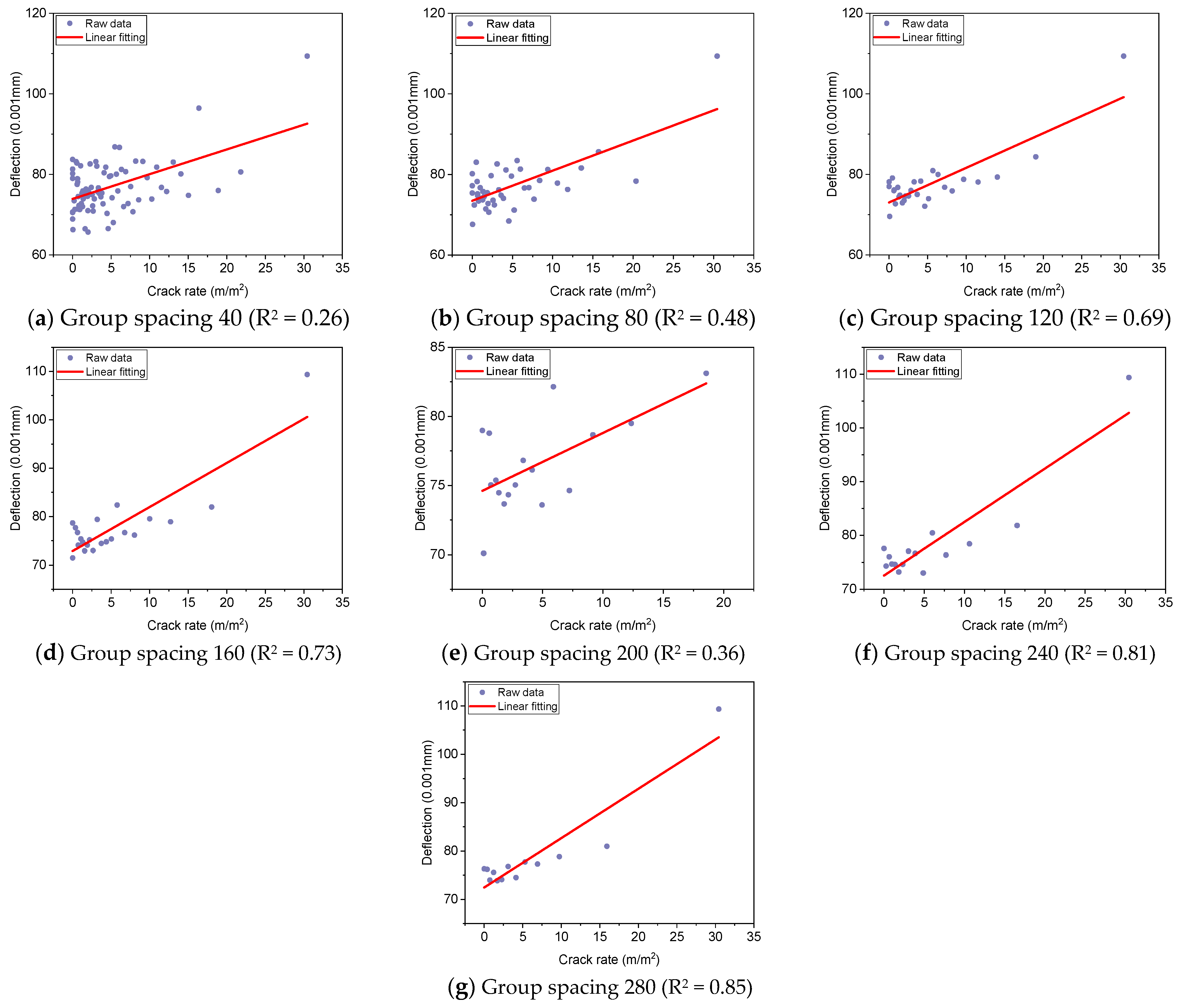






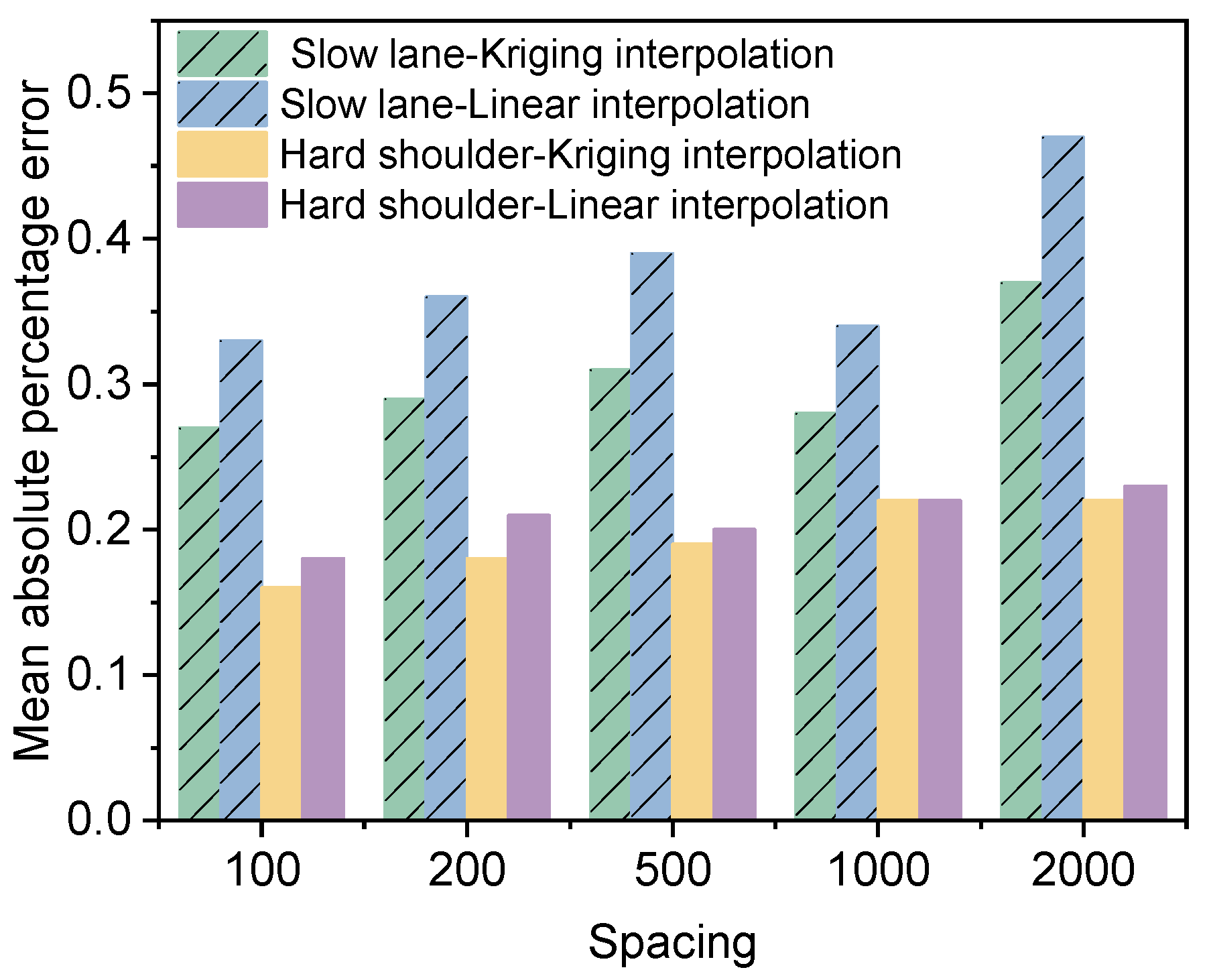
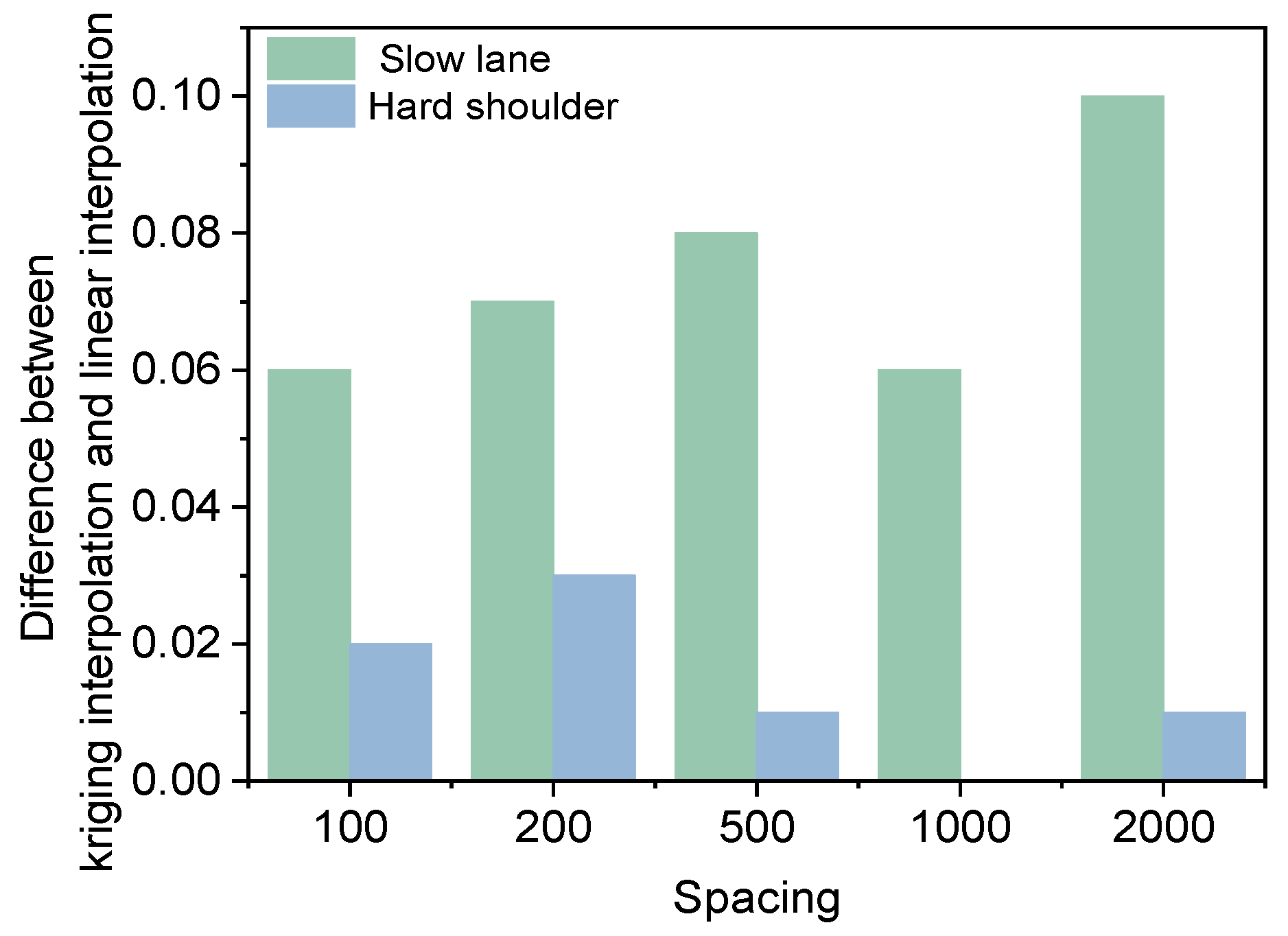

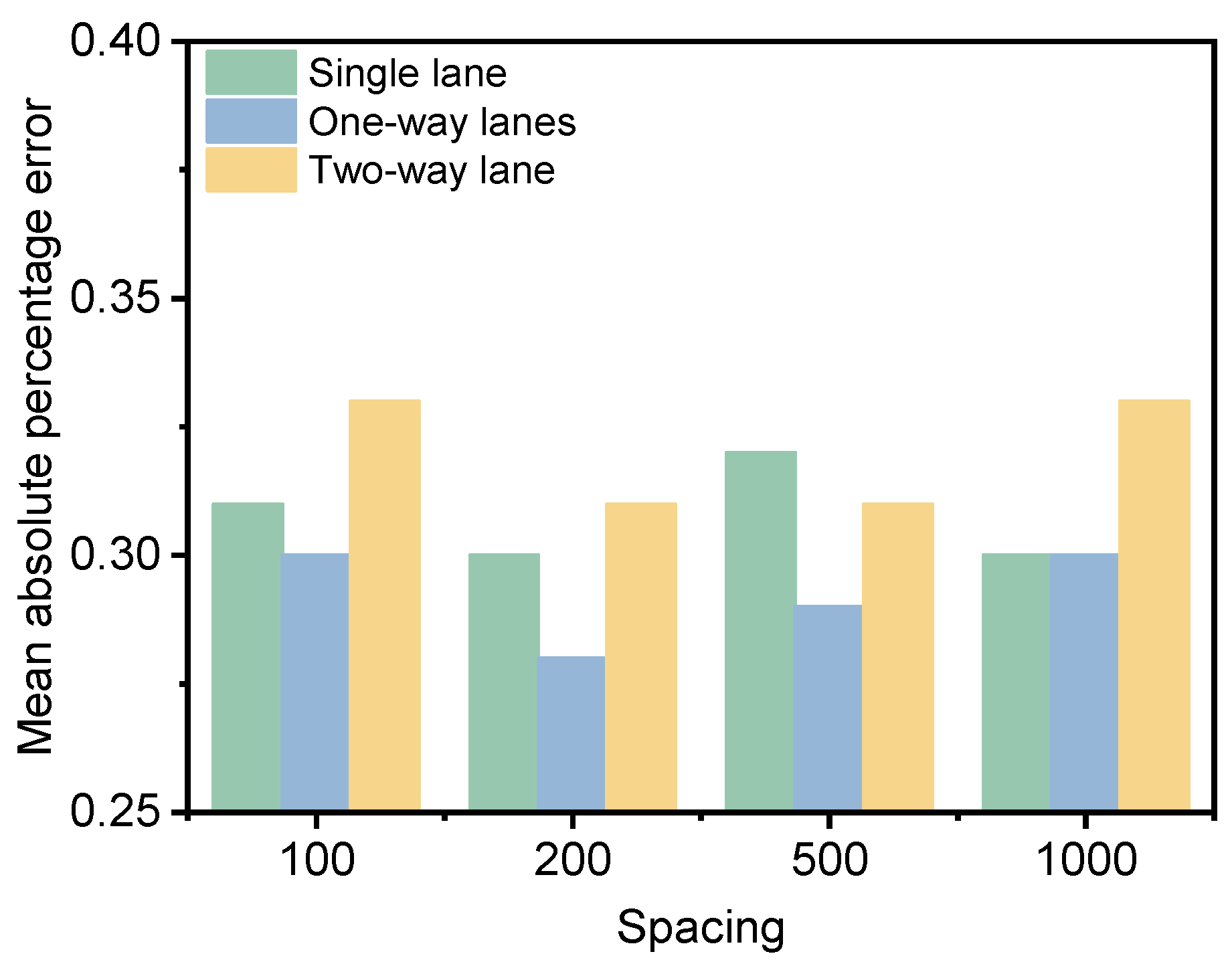

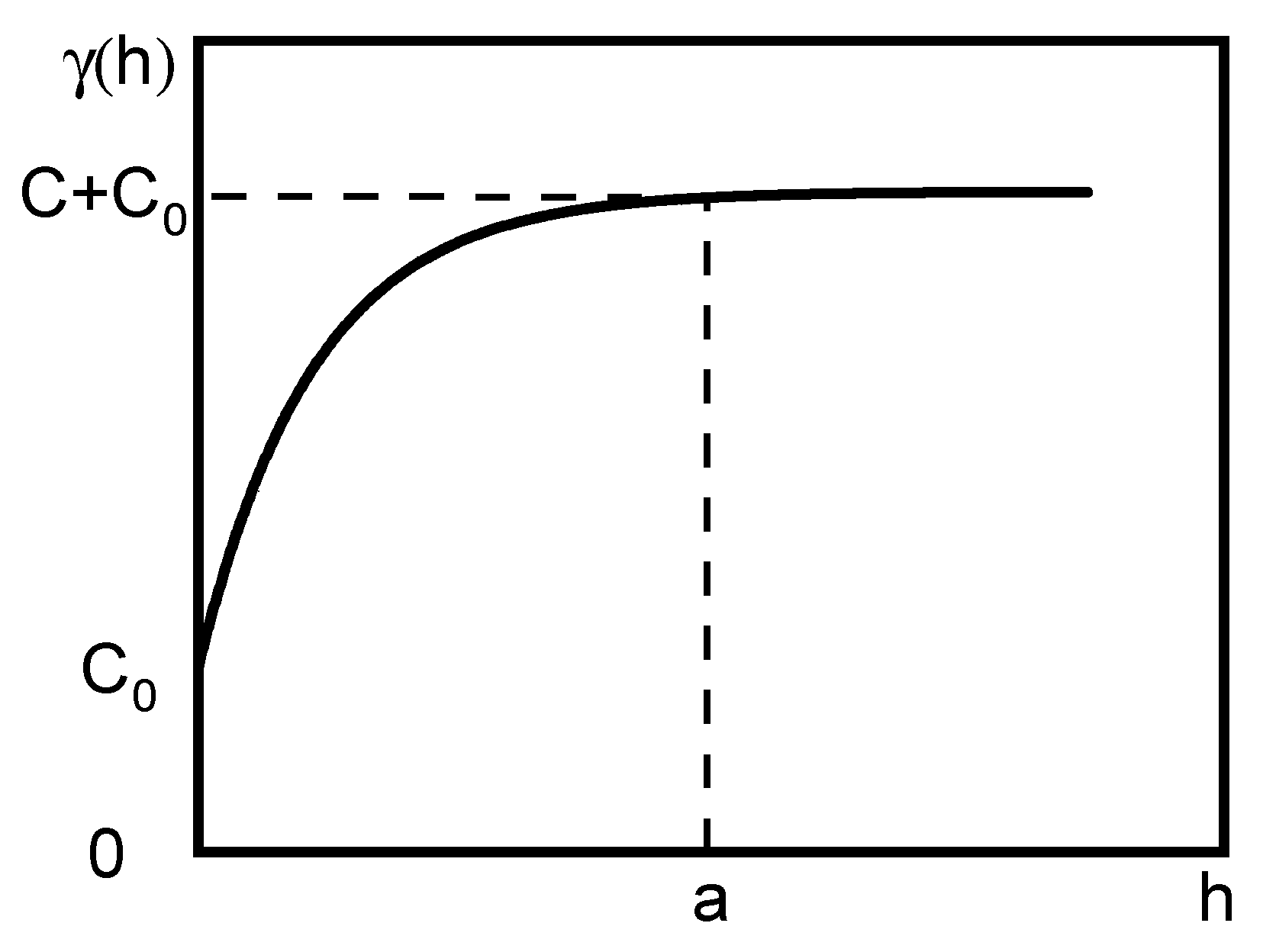

| Expressway | Parameter | Intercept | Slope | Coefficient of Determination R2 |
|---|---|---|---|---|
| Guangyun | Mean | 74.0 | 0.60 | 0.48 |
| Coefficient of variation | 1% | 35% | 58% | |
| Yangmao | Mean | 89.7 | 1.52 | 0.9 |
| Coefficient of variation | 1% | 6% | 19% |
| Traffic Lane | Direction | Guangyun Expressway | Yangmao Expressway |
|---|---|---|---|
| Slow lane | Left | 375 | 511 |
| Right | 105 | 366 | |
| Hard shoulder | Left | 2580 | 2668 |
| Right | 1464 | 5590 |
Disclaimer/Publisher’s Note: The statements, opinions and data contained in all publications are solely those of the individual author(s) and contributor(s) and not of MDPI and/or the editor(s). MDPI and/or the editor(s) disclaim responsibility for any injury to people or property resulting from any ideas, methods, instructions or products referred to in the content. |
© 2025 by the authors. Licensee MDPI, Basel, Switzerland. This article is an open access article distributed under the terms and conditions of the Creative Commons Attribution (CC BY) license (https://creativecommons.org/licenses/by/4.0/).
Share and Cite
Wang, D.; Luo, C.; Fu, M.; Zhang, W.; Xie, W. Study on Non-Destructive Testing Method of Existing Asphalt Pavement Based on the Principle of Geostatistics. Materials 2025, 18, 1848. https://doi.org/10.3390/ma18081848
Wang D, Luo C, Fu M, Zhang W, Xie W. Study on Non-Destructive Testing Method of Existing Asphalt Pavement Based on the Principle of Geostatistics. Materials. 2025; 18(8):1848. https://doi.org/10.3390/ma18081848
Chicago/Turabian StyleWang, Duanyi, Chuanxi Luo, Meng Fu, Wenting Zhang, and Wenjie Xie. 2025. "Study on Non-Destructive Testing Method of Existing Asphalt Pavement Based on the Principle of Geostatistics" Materials 18, no. 8: 1848. https://doi.org/10.3390/ma18081848
APA StyleWang, D., Luo, C., Fu, M., Zhang, W., & Xie, W. (2025). Study on Non-Destructive Testing Method of Existing Asphalt Pavement Based on the Principle of Geostatistics. Materials, 18(8), 1848. https://doi.org/10.3390/ma18081848







